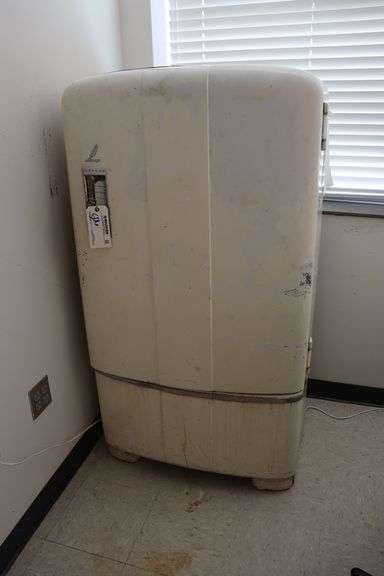For aficionados of all things vintage, there exists an ineffable charm in the classic appliances of yesteryear. Among these nostalgic relics lies the Vintage Leonard refrigerator, an appliance that harkens back to a time when craftsmanship took precedence over mass production. Enshrined in a lustrous oak veneer, this refrigerator isn’t just a utility; it’s a testament to an era characterized by elegance, style, and durability. As you ponder the challenge of restoring a Vintage Leonard refrigerator, brace yourself for a whirlwind journey that blends aesthetic grace with hands-on restoration work. Are you up for it?
Before embarking on this venture, it’s essential to understand what makes the Vintage Leonard refrigerator a coveted piece. With its robust oak structure and intricate detailing, this appliance radiates an aura of sophistication. It invites onlookers not just to glance, but to linger. Picture a kitchen where eclectic styles coalesce; the presence of a Vintage Leonard refrigerator can significantly elevate the decor, serving as a conversation starter and a focal piece that resonates with historic charm.
However, the beauty of the Vintage Leonard refrigerator is matched by the intricacies of its restoration. A classic piece like this brings forth a multifaceted challenge. Are you prepared to delve into the nuances of restoration? To undertake this endeavor, you must first engage with the refrigerator’s history and design. Understanding the materials and mechanisms used in the 1930s and 1940s will arm you with the knowledge necessary for an effective restoration. These refrigerators were not merely square boxes; they often featured intricate carvings, beautifully handled doors, and a patina that reflects years of stories. Realistically, you may first face the daunting challenge of sourcing original parts. Websites, auction houses, and vintage appliance stores may become your allies in this quest for authenticity.
Once you’ve secured your Vintage Leonard refrigerator, your journey of restoration awaits. Start by assessing the appliance’s current state. Is the wood swollen or cracked? Are there tarnished metal hinges or signs of rust? Insulation and cooling systems of these antique units require a careful examination. Unlike today’s modern fridges that often rely on synthetic materials, the Vintage Leonard employs insulation methods that must be rejuvenated with care. This is where patience and skill converge, transforming your restoration project into an artwork.
Cleaning forms the next pivotal step in the restoration process. As you gently scrub the exterior, the stratified layers of grime and age will begin to reveal the sought-after natural finish beneath. Use mild, effective cleaners that will not mar the wood. A concoction of olive oil and vinegar might become your trusty ally: it cleans and nourishes the wood without aggressive chemicals. With every wipe, you’re not just cleaning; you’re reviving history itself.
The restoration will likely also entail reworking hardware. Brass handles and knobs might need a careful polish to restore their former luster. If parts are irreparable, consider working with a local craftsman who can replicate the originals. The challenge is to strike a balance between authenticity and practicality, and this is where creativity can prove invaluable. Can you envision a unique design that complements the vintage aesthetic while allowing for modern functionality?
Next comes a formidable facet of the vintage restoration journey: reconditioning the cooling system. Most vintage refrigerators rely on compressor mechanics, which can appear daunting unless you have prior experience. The first step is to ensure the compressor is functional and free of leaks. If it’s beyond repair, don’t succumb to dismay just yet! Various vintage appliance enthusiasts successfully convert to modern cooling units without losing the character of the original design. Are you prepared to take that leap?
Another significant hurdle is electrical safety. Ensure that all wiring meets contemporary safety standards. Employ a certified electrician to navigate this aspect if you aren’t confident in your knowledge. Again, historical accuracy might inspire you to seek out vintage wiring that replicates the original; however, the focus should be on maintaining safety without compromising the vintage look. Have the courage to modernize where necessary while preserving the charm of authenticity.
As the restoration nears completion, the aesthetic flourishes can reflect your personal style. Should you opt for a bold color that stands out or stick to a classic finish that complements vintage décor? Paint can transform appearances, infusing life into the refrigerator and the surrounding space. A tasteful selection of cabinetry or an accompanying vintage-style kitchen layout is often the proverbial cherry on top. The key here lies in harmonizing the refrigerator with its environment, creating a seamless blend of old and new.
At its essence, restoring a Vintage Leonard refrigerator is an undertaking that goes beyond the realm of mere appliance renovation; it’s a journey of self-discovery and a testament to nostalgia. Can you forge a connection with the past while embracing modern elegance? Every scratch you invite to smooth over, every unique flaw you learn to appreciate, and every repair you master will deepen your connection to the age-old craftsmanship encapsulated within the refrigerator.
In the end, the challenge lies not just in the restoration of a Vintage Leonard refrigerator but in capturing the very essence of what it means to cherish the past. Are you ready to rise to the occasion? Your vintage charm awaits.

